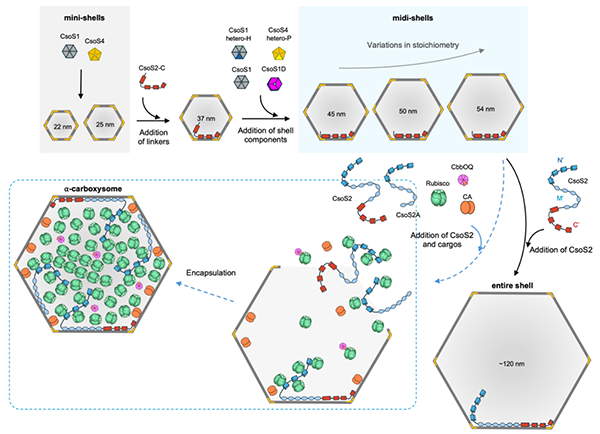Recently, OUC’s research team led by Professor Zhang Yuzhong from College of Marine Life Sciences and Key Laboratory of Marine Biodiversity and Evolution, in collaboration with Professor Liu Luning, published a research paper titled Molecular principles of the assembly and construction of a carboxysome shell in Science Advances. In this study, researchers used synthetic biology techniques to design and construct an artificial carboxysome shell that contains all the shell proteins and the C-terminal domain of the key linker protein CsoS2 (CsoS2-C). The structure of the carboxysome shell and the complex interactions among various protein components were analyzed, providing new insights into the molecular mechanisms of the self-assembly of the carboxysome shell, and laying a theoretical foundation for the reconstruction of carboxysomes and their biotechnological applications.
This study analyzed the structure of an artificially synthesized α-carboxysome shell that contains all the shell proteins and the C-terminal domain of the key linker protein CsoS2 (CsoS2-C). Cryo–electron microscopy at the atomic-resolution of the shell assemblies, with a maximal size of 54 nm, unveiled diverse assembly interfaces between shell proteins, and detailed interactions of CsoS2 with shell proteins to drive shell assembly. The study found that unlike the fixed inclination angles formed between hexamer and pentamer protein assemblies, the inclination angles between two hexamer assemblies are more complex and variable. The C-terminal domain CsoS1C of the linker protein forms multi-point interactions with the shell proteins and adopts two different conformations to facilitate shell assembly. Moreover, based on biochemical and crystallographic methods, the research revealed that homologs of hexamer and pentamer monomer proteins can form heterohexamers and heteropentamers.
The research findings have significantly deepened our understanding of the self-assembly mechanism of the carboxysome shell, offered new insights into the assembly principles of the α-carboxysome shell and the role of CsoS2 in regulating the assembly and function of the α-carboxysome, and laid a crucial foundation for the design and reprogramming of shell structures with new biotechnological functions.
